Methods For The Evaluation Of The Damage Limit State And Stiffness Regularity In Elevation Of Frame Systems In Seismic Areas
Price
Free (open access)
Transaction
Volume
81
Pages
12
Published
2005
Size
442 kb
Paper DOI
10.2495/ERES050721
Copyright
WIT Press
Author(s)
N. Caterino & E. Cosenza
Abstract
Recent earthquake resistant design codes (e.g. Eurocode 8, last Italian seismic code) underline the importance of stiffness regularity in elevation for frame systems located in seismic areas. Large deviations from a continuous variation with height of stiffness are likely to induce poor and often dangerous structural response (Paulay and Priestley). New codes emphasize moreover the importance of limiting non-structural damage under a seismic action having a large probability of occurrence during the economic life of a building. Actually non-structural components play a significant role in performance-based earthquake engineering. Damage limitation requirements consist in limiting interstorey drifts. Therefore, to evaluate and eventually redefine a new building’s preliminary design, it seems very useful to have a method to quickly calculate lateral stiffness of each storey so as to quantify its variation along the height of the building as well as a simple procedure to estimate the maximum lateral drift demands. Two approximate methods will be proposed for achieving these purposes. Keywords: non-structural damage, interstorey drift, storey stiffness, regularity. 1 Introduction In the last years the awareness about the importance of the buildings’ regularity and of the non-structural damage prevention for frame systems located in seismic areas has grown significantly, especially after the observation of the recent disastrous seismic events’ effects.
Keywords
non-structural damage, interstorey drift, storey stiffness, regularity.





